The Art of Public Speaking 12th Edition Page 28

The Greco-Buddhist fine art or Gandhara art of the north Indian subcontinent is the creative manifestation of Greco-Buddhism, a cultural syncretism betwixt Ancient Greek art and Buddhism.
The series of interactions leading to Gandhara fine art occurred over fourth dimension, outset with Alexander the Great's brief incursion into the area, followed by the Mauryan Emperor Ashoka converting the region to Buddhism.[ citation needed ] Buddhism became the prominent religion in the Indo-Greek Kingdoms. However, Greco-Buddhist art truly flowered and spread nether the Kushan Empire, when the first surviving devotional images of the Buddha were created during the 1st-3rd centuries CE.[i] Gandhara fine art reached its zenith from the 3rd-fifth century CE, when most surviving motifs and artworks were produced.[ane]
Gandhara fine art is characterized past Buddhist subject thing, sometimes adapting Greco-Roman elements, rendered in a mode and forms that are heavily influenced by Greco-Roman art. It has the strong idealistic realism and sensuous description of Hellenistic art, and it is believed to have produced the showtime representations of Gautama Buddha in human form, ending the early on period of aniconism in Buddhism.[2]
The representation of the man class in big sculpture had a considerable influence, both to the south in the rest of India, and to the east, where the spread of Buddhism carried its influence equally far as Japan.[3]
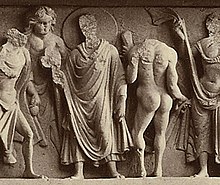
Historical Outline [edit]


The Indo-Greek Kingdoms in 100 BC.[5] [6] [vii]
There has been disagreement among art historians as to whether Gandharan fine art owes more to the civilization established immediately afterward Alexander's campaigns, or to a synthesis several centuries after between travelling Greco-Roman artists from the eastern Roman Empire in regions where Greek settlers were withal important. About of the considerable quantity of Gandharan fine art that tin be dated comes from after most 50 AD, although some clearly was created earlier.[8] For this reason, some scholars prefer to phone call this Romano-Indian art,[9] or talk of an "Indo-Classical style".[10]
The French scholar Alfred Foucher first identified the Western influences on Gandharan art at the end of the 19th century. He was initially a proponent of the continuity between the showtime Greek settlements and this art, and dated much of the art much earlier than more contempo scholars practise. However, he later revised his views and datings somewhat. His views as to dates and the crucial period of Western influence came to exist widely rejected, merely then received considerable support by the discovery of the important deserted city site of Ai-Khanoum (Alexandria on the Oxus), which was excavated in the 1960s and 1970s, where quantities of clearly Greek-influenced art were establish, datable to the 3rd and (mostly) 2nd centuries BC.[xi]
Greco-Buddhist fine art originated later on a series of cultural exchanges between populations. During the time of Alexander the Bully'due south armed forces campaign in the Indian subcontinent and Southern asia, Buddhism was by and large express to N Eastern Bharat and non common in North Western Republic of india, where the Greek satrapies formed. Buddhism was later widespread throughout S and Central Asia by the Maurya Empire. The Mauryan Emperor Ashoka converted his Greek subjects among others to Buddhism equally mentioned in his Edicts of Ashoka.[12]
Here in the king's domain among the Yavanas (Greeks), the Kambojas, the Nabhakas, the Nabhapamkits, the Bhojas, the Pitinikas, the Andhras and the Palidas, everywhere people are following Beloved-of-the-Gods' instructions in Dharma.
—Ashoka, Stone Edict 13
Afterward the overthrow of the Maurya Empire past the Shunga Empire, which did not extend to the north-western corners of the Mauryan territories, many of the Greek satrapies connected to practice Buddhism and developed the Greco-Buddhist art. This was evident during the reign of the Hellenistic Greco-Bactrian kingdom (250–130 BC) and the Indo-Greek kingdom (180–10 BC).[xiii] Under the Indo-Greeks and particularly later nether the Kushan Empire, Greco-Buddhist fine art flourished in the surface area of Gandhara and even spread to Key Asia, affecting the art of the Tarim Basin, every bit well as permeating again into India.[14]
The Yavana (Greek) male monarch Menander I was given the title of Soter ("Savior"), presumably for his aid of Buddhists that were being persecuted. Co-ordinate to the Milinda Panha, Menander was a devout Buddhist and accomplished the championship of an arhat, and was buried in a stupa according to the Buddhist manner. Following the death of Menander, the Indo-Greek Kingdoms disintegrated and their realm was conquered past invading Indo-Scythians or other regional entities. The Indo-Scythians were in turn subjugated by the Kushan Empire as the Western Satraps and the Kushan Empire would consolidate power throughout well-nigh of Central Asia and Due north Republic of india. The Kushan Emperor Kanishka, was also a devout Buddhist and Buddhism and its art flourished during the Kushan Era. Furthermore, he was responsible for spreading Mahayana Buddhism and Buddhist art throughout the Silk Road.
Early on Buddhist Fine art and Aniconic Buddhist Representations [edit]
Buddhist art outset became axiomatic and widespread under the Maurya Empire during the reign of Ashoka the Great.[fifteen] Mauryan art heavily influenced early Buddhist fine art and its iconography. This is evident in the art institute throughout the Maurya Empire such as capitals including the Pillars of Ashoka, and stupas such as the Sanchi and Bharhut stupas, which were synthetic and beginning busy during the Maurya Era. Early Buddhist art, including Mauryan art, depicted various structures and symbols pertaining to dharmic religions which are all the same used today. Symbols such every bit the Dharmachakra, lotus, and the Bodhi tree have become common iconography representing Buddhism. Additionally, these Buddhist artforms included various mythological beings such as yakshas including Kubera and yakshini such as Chanda, too every bit angelic Devas (Suras) and Asuras. Furthermore, Mauryan art especially those found on reliefs throughout stupas, describe the life of the Buddha including his nascence, regal processions, the Cracking Divergence, enlightenment, and acension from this earth.
Interestingly, although these sculptures draw other humans and various divinities in anthropomorphic forms, the Buddha is purposefully non shown in a homo representation. Instead, the Buddha is depicted with various symbols.[16] This includes a riderless equus caballus depicting his departure from his kingdom as shown on the Bharhut stupa. A Bodhi tree to depict the Shakyamuni Buddha achieving enlightenment. Every bit well every bit the Buddha footprints to convey his legacy after moving on from this earth. At that place is much contend on why the Buddha was not depicted as a human different other sculptures found throughout Buddhist art. It is considered that the orthodox Buddhists choose not to stand for the Shakyamuni Buddha out of respect, equally giving him a man class would spring him to this Earth every bit a living being which contradicts him obtaining his goal of enlightenment and achieving moksha.[16]
Hellenistic art in South asia [edit]

Silver coin depicting the Greco-Bactrian male monarch Demetrius I (200–180 BC) wearing an elephant scalp, symbol of his conquest of Bharat. Back: Herakles, holding a lion pare and a society resting over the arm. The text reads: ΒΑΣΙΛΕΩΣ ΔΗΜΗΤΡΙΟΥ – BASILÉŌS DĒMĒTRÍOU "of King Demetrius".
The clearest examples of Hellenistic fine art are establish in the coins of the Greco-Bactrian kings of the period, such as Demetrius I of Bactria. Many coins of the Greco-Bactrian kings have been unearthed, including the largest silver and gilded coins ever minted in the Hellenistic earth, ranking amidst the best in artistic and technical sophistication: they "show a degree of individuality never matched by the frequently more bland descriptions of their royal contemporaries further West". ("Hellenic republic and the Hellenistic world").

These Hellenistic kingdoms established cities on the Greek model, such every bit in Ai-Khanoum in Bactria, displaying purely Hellenistic architectural features, Hellenistic statuary, and remains of Aristotelician papyrus prints and coin hoards.
These Greek elements penetrated Bharat quite early every bit shown past the Hellenistic Pataliputra uppercase[17] (third century BC) during the Maurya Era, but the influence became peculiarly stiff, peculiarly in northwestern India following the invasion of the Greco-Bactrians in 180 BC, with the establishment of the Indo-Greek kingdom in India. Architectural styles used Hellenistic decorative motifs such as fruit garland and scrolls. Stone palettes for aromatic oils representing purely Hellenistic themes such as a Nereid riding a Ketos sea monster are found.
Early on Gandhara creations: stone palettes (2nd century BC – 1st century AD) [edit]
The Greeks in Asia are well known archaeologically for their stone palettes, also called "toilet trays", round trays commonly institute in the areas of Bactria and Gandhara, which usually represent Greek mythological scenes. The primeval of them are attributed to the Indo-Greek flow in the 2nd and 1st century BCE (a few were retrieved from the Indo-Greek stratum No.5 at Sirkap).[eighteen] [nineteen] Production continued until the time of the Indo-Parthians, but they practically disappeared after the 1st century.
Interaction [edit]
As shortly as the Greeks invaded Northwestern South Asia to form the Indo-Greek kingdom, a fusion of Hellenistic and Buddhist elements started to appear, encouraged by the benignancy of the Greek kings towards Buddhism. This artistic trend then adult for several centuries and seemed to flourish further during the Kushan Empire from the 1st century Advertizing.
Early contributions of Gandharan artists to Buddhist fine art (2nd-1st century BC) [edit]
According to some authors, Hellenistic sculptors had some connection with the creation of Buddhist art at Sanchi and Bharhut.[xx] The structure as a whole too as various elements point to Hellenistic and other strange influence, such every bit the fluted bong, addorsed capital of the Persepolitan lodge, and the arable apply of the Hellenistic flame palmette or honeysuckle motif.[21]
Sanchi [edit]
Around 115 BC, the embassy of Heliodorus from king Antialkidas to the courtroom of the Sungas king Bhagabhadra in Vidisha is recorded. In the Sunga capital, Heliodorus synthetic the Heliodorus colonnade in a dedication to Vāsudeva. This would indicate that relations between the Indo-Greeks and the Sungas had improved by that time, that people traveled between the 2 realms, and likewise that the Indo-Greeks readily followed Indian religions.[22]
Also around the same time, circa 115 BC, information technology is known that architectural decorations such as decorative reliefs started to be introduced at nearby Sanchi, half-dozen km away from Vidisha, by craftsmen from the expanse of Gandhara, a cardinal Indo-Greek region.[23] [24] Typically, the earliest medallions at Sanchi Stupa No.2 are dated to 115 BC, while the more extensive pillar carvings are dated to eighty BC.[25] These early decorative reliefs were apparently the work of craftsmen from the northwest (around the surface area of Gandhara), since they left stonemason'south marks in Kharoshthi, as opposed to the local Brahmi script.[23] [24] This seems to imply that these strange workers were responsible for some of the earliest motifs and figures that tin be found on the railings of the stupa.[23] [24]
Bharhut [edit]

Craftsmen from the Gandhara area, a central region of the Indo-Greek realm, are known to have been involved in the construction of the gateways at Bharhut, which are dated to 100-75 BC:[30] [31] this is because mason'south marks in Kharosthi take been found on several elements of the Bharhut remains, indicating that some of the builders at least came from the northward, particularly from Gandhara where the Kharoshti script was in use.[28] [21] [32]

Statues on the architraves of the torana gateway, associated with Kharosthi marks. 100-75 BC.
Cunningham explained that the Kharosthi letters were constitute on the ballusters between the architraves of the gateway, but none on the railings which all had Indian markings, summarizing that the gateways, which are artistically more refined, must have been made by artists from the N, whereas the railings were fabricated by local artists.[29] The Bharhut gateway is dated to 100-75 BC (almost probably 75 BC based on artistic assay).[30]
The structure equally a whole every bit well as various elements point to Hellenistic and other strange influence, such every bit the fluted bell, addorsed upper-case letter of the Persepolitan society, and the arable use of the Hellenistic flame palmette or honeysuckle motif.[21]
Characteristics of Greco-Buddhist art [edit]
Artistic model [edit]
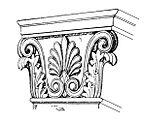


Afterwards, Greco-Buddhist art depicts the life of the Buddha in a visual manner, probably by incorporating the real-life models and concepts which were bachelor to the artists of the period.
The Bodhisattvas are depicted as bare-chested and jewelled Indian princes, and the Buddhas equally Greek kings wearing the light toga-like himation. The buildings in which they are depicted contain Greek way, with the ubiquitous Indo-Corinthian capitals and Greek decorative scrolls. Surrounding deities course a pantheon of Greek (Atlas, Herakles) and Indian gods (Indra).
Material [edit]
Stucco equally well as stone was widely used by sculptors in Gandhara for the decoration of monastic and cult buildings. Stucco provided the creative person with a medium of cracking plasticity, enabling a high degree of expressiveness to be given to the sculpture. Sculpting in stucco was popular wherever Buddhism spread from Gandhara - India, Transitional islamic state of afghanistan, Central Asia and China.
Stylistic evolution [edit]
Stylistically, Greco-Buddhist art started by existence extremely fine and realistic, every bit apparent on the standing Buddhas, with "a realistic treatment of the folds and on some even a hint of modelled book that characterizes the best Greek work" (Boardman). Information technology then lost this sophisticated realism, becoming progressively more symbolic and decorative over the centuries.
Architecture [edit]

The Titan Atlas, supporting a Buddhist monument, Hadda.
The presence of stupas at the Greek city of Sirkap, which was built by Demetrius effectually 180 BC, already indicates a strong syncretism between Hellenism and the Buddhist faith, together with other religions such as Hinduism and Zoroastrianism. The manner is Greek, adorned with Corinthian columns in first-class Hellenistic execution.
Later on in Hadda, the Greek divinity Atlas is represented holding Buddhist monuments with decorated Greek columns. The motif was adopted extensively throughout the Indian sub-continent, Atlas being substituted for the Indian Yaksa in the monuments of the Shunga Empire around the 2nd century BC.
Buddha [edit]

Seated Buddha in Hellenistic mode, Tapa Shotor, 2nd century AD.[33] [34]
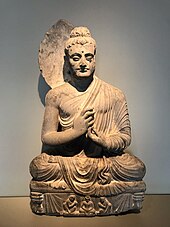
Former betwixt the 2nd century BC and the 1st century AD, the outset anthropomorphic representations of the Buddha were developed. These were absent from earlier strata of Buddhist art, which preferred to represent the Buddha with symbols such as the stupa, the Bodhi tree, the empty seat, the bicycle, or the footprints. Merely the innovative anthropomorphic Buddha image immediately reached a very high level of sculptural sophistication, naturally inspired by the sculptural styles of Hellenistic Greece.

The Buddha pedagogy. Kushan period. National Museum, Delhi. 2004
Many of the stylistic elements in the representations of the Buddha point to Greek influence: the Greek himation (a light toga-similar wavy robe roofing both shoulders: Buddhist characters are always represented with a dhoti loincloth before this innovation), the halo, the contrapposto opinion of the upright figures, the stylized Mediterranean curly pilus and pinnacle-knot plainly derived from the manner of the Dais Apollo (330 BC), and the measured quality of the faces, all rendered with strong creative realism (Meet: Greek art). Some of the standing Buddhas (as the ane pictured) were sculpted using the specific Greek technique of making the hands and sometimes the feet in marble to increase the realistic effect, and the residual of the torso in some other material.
Foucher especially considered Hellenistic free-standing Buddhas every bit "the virtually beautiful, and probably the most ancient of the Buddhas", assigning them to the 1st century BC, and making them the starting betoken of the anthropomorphic representations of the Buddha ("The Buddhist fine art of Gandhara", Marshall, p101).
Evolution [edit]
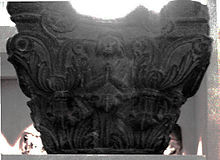

There is some debate regarding the verbal engagement for the development of the anthropomorphic representation of the Buddha, and this has a bearing on whether the innovation came directly from the Indo-Greeks, or was a after development by the Indo-Scythians, the Indo-Parthians or the Kushans under Hellenistic creative influence. Well-nigh of the early images of the Buddha (peculiarly those of the standing Buddha) are anepigraphic, which makes it difficult to have a definite dating. The primeval known prototype of the Buddha with approximate indications on date is the Bimaran casket, which has been found buried with coins of the Indo-Scythian king Azes II (or possibly Azes I), indicating a 30–10 BC date, although this engagement is not undisputed.
Such datation, too as the general Hellenistic style and mental attitude of the Buddha on the Bimaran catafalque (himation dress, contrapposto attitude, full general depiction) would make it a possible Indo-Greek work, used in dedications by Indo-Scythians soon subsequently the end of Indo-Greek rule in the area of Gandhara. Since it already displays quite a sophisticated iconography (Brahma and Śakra every bit attendants, Bodhisattvas) in an advanced style, it would suggest much earlier representations of the Buddha were already current by that time, going back to the rule of the Indo-Greeks (Alfred A. Foucher and others).
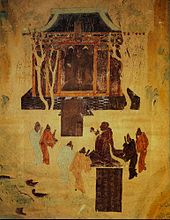
The next Greco-Buddhist findings to be strictly datable are rather belatedly, such as the c. AD 120 Kanishka casket and Kanishka's Buddhist coins. These works at least indicate though that the anthropomorphic representation of the Buddha was already extant in the 1st century Advert.
From another direction, Chinese historical sources and mural paintings in the Tarim Basin city of Dunhuang accurately depict the travels of the explorer and administrator Zhang Qian to Central Asia as far as Bactria around 130 BC, and the same murals draw the Emperor Han Wudi (156–87 BC) worshipping Buddhist statues, explaining them as "golden men brought in 120 BC past a neat Han general in his campaigns against the nomads." Although there is no other mention of Han Wudi worshipping the Buddha in Chinese historical literature, the murals would suggest that statues of the Buddha were already in beingness during the 2nd century BC, connecting them directly to the time of the Indo-Greeks.
Later, the Chinese historical chronicle Hou Hanshu describes the enquiry about Buddhism made around AD 67 by the emperor Emperor Ming (Advertisement 58–75). He sent an envoy to the Yuezhi in northwestern India, who brought back paintings and statues of the Buddha, confirming their beingness before that date:
- "The Emperor, to discover the truthful doctrine, sent an envoy to Tianzhu (天竺, Northwestern India) (Northwestern India) to inquire about the Buddha's doctrine, later on which paintings and statues [of the Buddha] appeared in the Middle Kingdom." (Hou Hanshu, trans. John Hill)
An Indo-Chinese tradition also explains that Nagasena, also known as Menander'due south Buddhist teacher, created in 43 BC in the metropolis of Pataliputra a statue of the Buddha, the Emerald Buddha, which was later brought to Thailand.
Artistic model [edit]
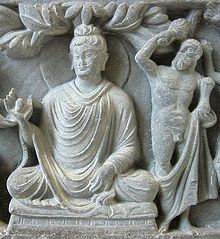
In Gandharan fine art, the Buddha is often shown under the protection of the Greek god Herakles, standing with his club (and later a diamond rod) resting over his arm.[35] This unusual representation of Herakles is the same as the one on the back of Demetrius' coins, and it is exclusively associated to him (and his son Euthydemus 2), seen only on the back of his coins.
Soon, the effigy of the Buddha was incorporated within architectural designs, such as Corinthian pillars and friezes. Scenes of the life of the Buddha are typically depicted in a Greek architectural environment, with protagonist wearing Greek dress.
Gods and Bodhisattvas [edit]


Deities from the Greek mythological pantheon also tend to be incorporated in Buddhist representations, displaying a strong syncretism. In particular, Herakles (of the type of the Demetrius coins, with lodge resting on the arm) has been used abundantly as the representation of Vajrapani, the protector of the Buddha.[36] Other Greek deities abundantly used in Greco-Buddhist art are representation of Atlas, and the Greek air current god Boreas. Atlas in item tends to be involved as a sustaining elements in Buddhist architectural elements. Boreas became the Japanese air current god Fujin through the Greco-Buddhist Wardo. The female parent deity Hariti was inspired past Tyche.
Especially under the Kushans, at that place are too numerous representations of richly adorned, princely Bodhisattvas all in a very realistic Greco-Buddhist style. The Bodhisattvas, feature of the Mahayana form of Buddhism, are represented under the traits of Kushan princes, completed with their canonical accessories.
-
-

Winged Atalante.
-
-
-

"Laughing boy" from Hadda
-

Head of a bodhisattva, Gandhara ca. 4th century
Cupids [edit]
Winged cupids are another popular motif in Greco-Buddhist fine art. They usually fly in pair, property a wreath, the Greek symbol of victory and kingship, over the Buddha.

These figures, also known equally "apsarases" were extensively adopted in Buddhist fine art, especially throughout Eastern asia, in forms derivative to the Greco-Buddhist representation. The progressive evolution of the fashion can be seen in the art of Qizil and Dunhuang. It is unclear nonetheless if the concept of the flying cupids was brought to Republic of india from the West, of if it had an independent Indian origin, although Boardman considers information technology a Classical contribution: "Some other Classical motif we found in India is the pair of hovering winged figures, generally called apsaras." (Boardman)
Scenes of cupids holding rich garlands, sometimes adorned with fruits, is another very popular Gandharan motif, directly inspired from Greek art. It is sometimes argued that the only concession to Indian art appears in the anklets worn by the cupids. These scenes had a very broad influence, as far as Amaravati on the eastern coast of Republic of india, where the cupids are replaced by yakṣas.
Devotees [edit]

Some Greco-Buddhist friezes represent groups of donors or devotees, giving interesting insights into the cultural identity of those who participated in the Buddhist cult.
Some groups, often described as the "Buner reliefs," usually dated to the 1st century AD, depict Greeks in perfect Hellenistic style, either in posture, rendering, or clothing (wearing the Greek chiton and himation). It is sometimes even difficult to perceive an actual religious message behind the scenes. (The devotee scene on the right might, with doubt, depict of the presentation of Prince Siddharta to his bride. It may besides only be a festive scene.)
Nigh a century after, friezes as well draw Kushan devotees, usually with the Buddha every bit the fundamental effigy.
Fantastic animals [edit]
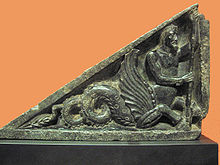
Diverse fantastic brute deities of Hellenic origin were used as decorative elements in Buddhist temples, often triangular friezes in staircases or in forepart of Buddhist altars. The origin of these motifs can be constitute in Hellenic republic in the 5th century BC, and afterwards in the designs of Greco-Bactrian perfume trays every bit those discovered in Sirkap. Among the about pop fantastic animals are tritons, ichthyo-centaurs and ketos sea-monsters. Similar fantastic animals are found in ancient Egyptian reliefs, and might therefore have been passed on to Bactria and Republic of india independently.
As fantastic animals of the bounding main, they were, in early Buddhism, supposed to safely bring the souls of expressionless people to Paradise beyond the waters. These motifs were subsequently adopted in Indian fine art, where they influenced the depiction of the Indian monster makara, Varuna's mount.
Kushan contribution [edit]


The afterwards part of Greco-Buddhist art in northwestern India is usually associated with the Kushan Empire. The Kushans were nomadic people who started migrating from the Tarim Basin in Central Asia from around 170 BC and concluded up founding an empire in northwestern India from the 2nd century BC. Later on acquisition the lands one time inhabited by Greco-Bactrians and Indo-Greeks, the Kushan Empire adopted Greco-Buddhist art.
-
Maitreya, with Kushan devotee couple. 2nd century Gandhara.
-
Maitreya, with Kushan devotees, left and right. 2d century Gandhara.
-
Maitreya, with Indian (left) and Kushan (correct) devotees.
-
Kushans worshipping the Buddha'south bowl. 2nd century Gandhara.
-
Kushan devotee couple, around the Buddha, Brahma and Indra.
-
Buddha triad and kneeling Kushan devotee couple. third century.
Later period (5th-7th centuries) [edit]
The Greco-Buddhist art of Gandhara essentially ends with the 5th-7th centuries. A late development is the advent of a halo and mandorla surrounding the Buddha figure.[37] The final stages stand for roughly to the destruction of the Alchon Huns, when the art of Gandhara, becomes essentially extinct. When Xuanzang visited northwestern India in c. 630 Advertizement, he reported that Buddhism had drastically declined, and that most of the monasteries were deserted and left in ruins.[38]
-

Seated Buddha with halo and mandorla 5th-6th century Gandhara.
-

The Buddha with a radiate mandorla, Gandhara, 6th century
Southern influences [edit]
Art of the Shunga [edit]
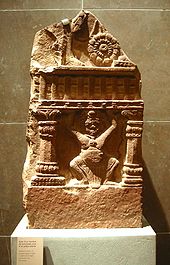
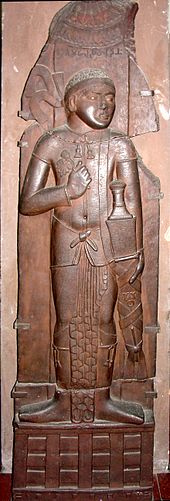
Examples of the influence of Hellenistic or Greco-Buddhist art on the art of the Shunga Empire (183-73 BC) are commonly faint. The chief religion, at least at the beginning, seems to have been Brahmanic Hinduism, although some belatedly Buddhist realizations in Madhya Pradesh as also known, such as some architectural expansions that were washed at the stupas of Sanchi and Bharhut, originally started nether King Ashoka.
Art of Mathura [edit]


A Bodhisattva, 2nd century, Mathura
The representations of the Buddha in Mathura, in central northern India, are generally dated slightly later than those of Gandhara, although not without debate, and are also much less numerous. Up to that point, Indian Buddhist fine art had substantially been aniconic, avoiding representation of the Buddha, except for his symbols, such as the bicycle or the Bodhi tree, although some archaic Mathuran sculptural representation of Yaksas (earth divinities) have been dated to the 1st century BC. Even these Yaksas point some Hellenistic influence, possibly dating back to the occupation of Mathura past the Indo-Greeks during the 2nd century BC.
In terms of artistic predispositions for the get-go representations of the Buddha, Greek art provided a very natural and centuries-sometime background for an anthropomorphic representation of a divinity, while on the contrary "at that place was nada in earlier Indian bronze to suggest such a handling of form or dress, and the Hindu pantheon provided no adequate model for an aristocratic and wholly human being deity" (Boardman).

Greek curl supported by Indian Yaksas, Amaravati, 3rd century AD
The Mathura sculptures incorporate many Hellenistic elements, such as the general idealistic realism, and key design elements such as the curly hair, and folded garment. Specific Mathuran adaptations tend to reverberate warmer climatic conditions, equally they consist in a higher fluidity of the vesture, which progressively tend to encompass only one shoulder instead of both. Besides, facial types too tend to get more Indianized. Banerjee in Hellenism in ancient Bharat describes "the mixed character of the Mathura School in which we detect on the one manus, a direct continuation of the onetime Indian art of Bharhut and Sanchi and on the other hand, the classical influence derived from Gandhara".
The influence of Greek fine art can exist felt beyond Mathura, every bit far as Amaravati on the East coast of Republic of india, equally shown by the usage of Greek scrolls in combination with Indian deities. Other motifs such as Greek chariots pulled by four horses can besides be found in the same area.
Incidentally, Hindu fine art started to develop from the 1st to the 2nd century Ad and establish its first inspiration in the Buddhist art of Mathura. Information technology progressively incorporated a profusion of original Hindu stylistic and symbolic elements nonetheless, in contrast with the general balance and simplicity of Buddhist art.
The art of Mathura features frequent sexual imagery. Female person images with bare breasts, nude below the waist, displaying labia and female ballocks are common. These images are more than sexually explicit than those of earlier or afterward periods.
Arts of Western India [edit]
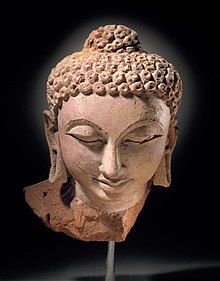
A terracotta head of Buddha Shakyamuni, inspired by Greco-Buddhist art, Devnimori, Gujarat (375-400 AD).

The Buddha in long, heavy robe, a design derived from the art of Gandhara, Ajanta Caves, 5th century Advertizement.[39]
It has been suggested that the art of Devnimori in Gujarat, dated to the quaternary century Advertizement, represented a Western Indian artistic tradition, based on the influence of the Greco-Buddhist art of Gandhara, that was anterior to the rise of Gupta Empire art, and that it may have influenced it, and take influenced the art of the Ajanta Caves, Sarnath and other places from the 5th century onward.[xl] Devnimori may also accept received some influence from Mathura art.[40] At Ajanta, some connections with the art of Gandhara can be noted, and at that place is evidence of a shared artistic idiom.[41]
The site of Devnimori included numerous terracotta Buddhist sculptures (only no stone sculptures), which are among the earliest sculptures that tin exist plant in Gujarat.[42] The mode is clearly influenced past the Greco-Buddhist art of Gandhara.[43]
The Indo-Scythian Western Satraps (1st century Advertizement-405 AD may accept played a role in the transmission of the fine art of Gandhara to the western Deccan region, every bit may also take the southern expansion of the Alchon Huns in the 6th-seventh century.[41]
Art of the Gupta [edit]

Buddha of the Gupta period, 5th century, Mathura.

Caput of a Buddha, Gupta period, 6th century.
The art of Mathura acquired progressively more Indian elements and reached a very high sophistication during the Gupta Empire, between the 4th and the 6th century Advertising. The art of the Gupta is considered every bit the last height of Indian art, although the Gupta dynasty were Hindu, and Buddhism was now in decline in India.
Hellenistic elements are nevertheless conspicuously visible in the purity of the statuary and the folds of the wear, but are improved upon with a very delicate rendering of the draping and a sort of radiance reinforced by the usage of pink sandstone. Creative details tend to exist less realistic, as seen in the symbolic shell-like curls used to render the hairstyle of the Buddha.
Expansion in Cardinal Asia [edit]
Greco-Buddhist artistic influences naturally followed Buddhism in its expansion to Central and East asia from the 1st century BC.
Bactria [edit]
Bactria was under directly Greek control for more two centuries from the conquests of Alexander the Great in 332 BC to the end of the Greco-Bactrian kingdom effectually 125 BC. The fine art of Bactria was well-nigh perfectly Hellenistic as shown by the archaeological remains of Greco-Bactrian cities such equally Alexandria on the Oxus (Ai-Khanoum), or the numismatic art of the Greco-Bactrian kings, often considered equally the all-time of the Hellenistic earth, and including the largest silver and gold coins e'er minted by the Greeks.
When Buddhism expanded in Fundamental Asia from the 1st century Advertisement, Bactria saw the results of the Greco-Buddhist syncretism arrive on its territory from India, and a new blend of sculptural representation remained until the Islamic invasions.
The most striking of these realizations are the Buddhas of Bamyan. They tend to vary betwixt the 5th and the ninth century Advertising. Their way is strongly inspired by Hellenistic civilisation.
In another area of Bactria called Fondukistan, some Greco-Buddhist fine art survived until the seventh century in Buddhist monasteries, displaying a strong Hellenistic influence combined with Indian decorativeness and mannerism, and some influence by the Sasanid Persians.
Most of the remaining art of Bactria was destroyed from the 5th century onward: the Buddhists were often blamed for idolatry and tended to be persecuted past the iconoclastic Muslims. Destructions connected during the Transitional islamic state of afghanistan War, and especially by the Taliban regime in 2001. The most famous case is that of the destruction of the Buddhas of Bamyan. Ironically, most of the remaining art from Afghanistan still extant was removed from the country during the Colonial period. In particular, a rich collection exists at the Musee Guimet in France.
Tarim Basin [edit]
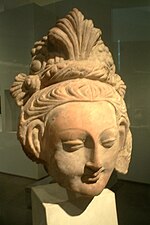
Head of a Bodhisattva, sixth-7th century terracotta, Tumshuq (Xinjiang).
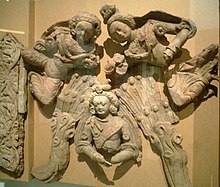
The art of the Tarim Basin, besides called Serindian art, is the art that developed from the 2nd through the 11th century in Serindia or Xinjiang, the western region of China that forms role of Central Asia. Information technology derives from the fine art of the Gandhara and clearly combines Indian traditions with Greek and Roman influences. Buddhist missionaries travelling on the Silk Road introduced this fine art, along with Buddhism itself, into Serindia, where it mixed with Chinese and Persian influences.
Influences in Eastern asia [edit]
The arts of China, Korea and Japan adopted Greco-Buddhist creative influences, but tended to add many local elements as well. What remains most readily identifiable from Greco-Buddhist art are:
- The general idealistic realism of the figures reminiscent of Greek fine art.
- Clothing elements with elaborate Greek-way folds.
- The curly hairstyle characteristic of the Mediterranean.
- In some Buddhist representations, hovering winged figures holding a wreath.
- Greek sculptural elements such as vines and floral scrolls.
Mainland china [edit]
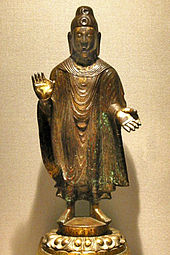
Northern Wei Buddha Maitreya, Advertizing 443.
Greco-Buddhist artistic elements can exist traced in Chinese Buddhist art, with several local and temporal variations depending on the character of the diverse dynasties that adopted the Buddhist organized religion. Some of the earliest known Buddhist artifacts constitute in Red china are small statues on "money trees", dated circa AD 200, in typical Gandharan style: "That the imported images accompanying the newly arrived doctrine came from Gandhara is strongly suggested by such early Gandhara characteristics on this "money tree" Buddha as the loftier ushnisha, vertical arrangement of the hair, moustache, symmetrically looped robe and parallel incisions for the folds of the arms."[44]
Some Northern Wei statues tin be quite reminiscent of Gandharan standing Buddha, although in a slightly more symbolic style. The general mental attitude and rendering of the dress however remain. Other, like Northern Qi Dynasty statues also maintain the general Greco-Buddhist mode, only with less realism and stronger symbolic elements.
Some Eastern Wei statues brandish Buddhas with elaborate Greek-style robe foldings, and surmounted by flying figures holding a wreath.
Japan [edit]


A Buddha in Kamakura (1252), reminiscent of Greco-Buddhist influences.
In Nihon, Buddhist art started to develop every bit the state converted to Buddhism in AD 548. Some tiles from the Asuka menstruum, the commencement period following the conversion of the country to Buddhism, brandish a strikingly classical style, with aplenty Hellenistic wearing apparel and realistically rendered body shape feature of Greco-Buddhist art.
Other works of art incorporated a variety of Chinese and Korean influences, and then that Japanese Buddhism became extremely varied in its expression. Many elements of Greco-Buddhist art remain to this day however, such as the Hercules inspiration behind the Nio guardian deities in front end of Japanese Buddhist temples, or representations of the Buddha reminiscent of Greek fine art such as the Buddha in Kamakura.[45]

Iconographical evolution of the Wind God.
Left: Greek current of air god from Hadda, 2d century.
Center: wind god from Kizil, Tarim Basin, 7th century.
Correct: Japanese wind god Fujin, 17th century.
Various other Greco-Buddhist creative influences can be institute in the Japanese Buddhist pantheon, the well-nigh hitting of which being that of the Japanese wind god Fujin. In consistency with Greek iconography for the wind god Boreas, the Japanese wind god holds to a higher place his head with his ii hands a draping or "air current handbag" in the same general attitude.[46] The affluence of hair have been kept in the Japanese rendering, equally well as exaggerated facial features.

Another Buddhist deity, named Shukongoshin, one of the wrath-filled protector deities of Buddhist temples in Japan, is likewise an interesting case of manual of the image of the famous Greek god Herakles to East asia along the Silk Route. Herakles was used in Greco-Buddhist art to correspond Vajrapani, the protector of the Buddha, and his representation was so used in People's republic of china and Japan to depict the protector gods of Buddhist temples.[47]
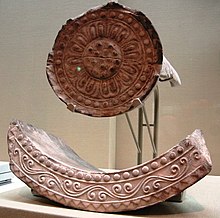
Temple tiles from Nara, 7th century.

Vine and grape scrolls from Nara, 7th century.
Finally, the artistic inspiration from Greek floral scrolls is found quite literally in the decoration of Japanese roof tiles, one of the merely remaining elements of wooden compages to have survived the centuries. The clearest ones are from 7th century Nara temple edifice tiles, some of them exactly depicting vines and grapes. These motifs accept evolved towards more symbolic representations, but essentially remain to this day in many Japanese traditional buildings.[48]
Influences on Southeast Asian art [edit]


The Indian civilization proved very influential on the cultures of Southeast Asia. Almost countries adopted Indian writing and culture, together with Hinduism and Mahayana and Theravada Buddhism.
The influence of Greco-Buddhist art is still visible in most of the representation of the Buddha in Southeast Asia, through their idealism, realism and details of apparel, although they tend to intermix with Indian Hindu art, and they progressively larn more local elements.
Cultural significance [edit]
Beyond stylistic elements which spread throughout Asia for shut to a millennium, the main contribution of Greco-Buddhist art to the Buddhist organized religion may be in the Greek-inspired idealistic realism which helped describe in a visual and immediately understandable manner the state of personal bliss and enlightenment proposed past Buddhism. The communication of deeply homo arroyo of the Buddhist faith, and its accessibility to all have probably benefited from the Greco-Buddhist artistic syncretism.[ co-ordinate to whom? ]
Museums [edit]
Major collections [edit]
- Peshawar Museum, Peshawar, Pakistan (largest drove in the world).
- Lahore Museum, Lahore, Pakistan.
- Taxila Museum, Taxila, Pakistan.
- National Museum of Islamic republic of pakistan, Karachi, Pakistan.
- Indian Museum, Kolkata, Westward Bengal, Bharat (largest collection in Bharat).
- Regime Museum and Fine art Gallery, Chandigarh, India (627 artifacts; second largest in India).
- Mathura Museum, Mathura, Bharat.
- Musée Guimet, Paris, France (about 150 artifacts, largest drove outside of Asia.)[49]
- British Museum, London, Swell U.k. (near 100 artifacts), such equally Seated Buddha from Gandhara
- Tokyo National Museum, Tokyo, Japan (about fifty artifacts)
- National Museum of Oriental Fine art, Rome, Italy (about eighty artifacts)
- Museum of Asian Art, Dahlem, Berlin, Germany.
Small collections [edit]
- Metropolitan Museum of Fine art, New York, United States
- Aboriginal Orient Museum, Tokyo, Japan (About 20 artifacts)
- Victoria and Albert Museum, London, Great United kingdom of great britain and northern ireland (Near 30 artifacts)
- City Museum of Aboriginal Fine art in Palazzo Madama, Turin, Italy.
- Rubin Museum of Art in New York City, NY, United States.
- National Museum, New Delhi, India
Private collections [edit]
- Collection de Marteau, Brussels, Belgium.
| Timeline and influence of Greco-Buddhist art | |||||
|---|---|---|---|---|---|
| Periods | Northern Asia | Central Asia | Gandhara | Bharat | Southeast Asia |
| 5th century BCE | Birth of Buddhism | ||||
| 4th century BCE | Occupation by Alexander the Slap-up (330 BCE) | ||||
| 3rd-2nd century BCE | Seleucid Empire (300-250BCE) ---------- | Mauryan Empire (321-185 BCE) (Aniconic art) | Introduction of Buddhism to Myanmar | ||
| 2nd-1st century BCE | China, Han dynasty Kickoff mention of Buddhist statues brought from Central Asia (120 BCE) | Indo-Greek kingdom (180 BCE-10 CE) Buddhist symbolism and proselytism | Shunga Empire (185-73 BCE) | ||
| 1st century BCE | Yuezhi Nomadic invaders, who became Hellenized and propagated Buddhism | Indo-Scythians (80-xx CE) | |||
| 1st century CE | Official start of Buddhism in China. Arrival of statues of the Buddha in 70 CE. | Indo-Parthians | Art of Mathura | ||
| 1st-third century CE | Commencement known Buddha statues in China (afterwards Han, c.200 CE) | Kushan Empire (10-350 CE) | |||
| fourth-sixth century CE | Tarim Basin People's republic of china   Start of Buddhism in Nihon | Bactria | Gupta Empire (320-550 CE) | Mahayana Buddhism in Siam, Cambodia and Vietnam | |
| 7th-13th century CE | Nippon  | Islamic invasions | Pala Empire (11th century)  | Southeast Asia  Introduction of Theravada from Sri Lanka in the 11th century | |
Encounter as well [edit]
- Buddhist art
- Greco-Buddhism
- Index of Buddhism-related manufactures
- History of Buddhism
Notes [edit]
- ^ a b "The fine art of Gandhara in the Metropolitan Museum of Fine art". Choice Reviews Online. 45 (4): 45–1823-45-1823. 2007-12-01. doi:10.5860/choice.45-1823. ISSN 0009-4978.
- ^ Chicken, 40, 70, 84; Harle, 126
- ^ Craven, 100-101; Harle, 84
- ^ Acri, Andrea (20 December 2018). "Maritime Buddhism". Oxford Research Encyclopedia of Religion. Oxford: Oxford University Press. doi:ten.1093/acrefore/9780199340378.013.638. ISBN9780199340378. Archived from the original on 19 February 2019. Retrieved xxx May 2021.
- ^ Davies, Cuthbert Collin (1959). An Historical Atlas of the Indian Peninsula. Oxford University Printing.
- ^ Narain, A.Yard. (1976). The Coin Types of the Indo-Greek Kings, 256-54 B.C. Ares. ISBN0-89005-109-7.
- ^ Stier, Hans Erich; Kirsten, Ernst; Aner, Ekkehard (1978). Grosser Atlas zur Weltgeschichte: Vorzeit, Altertum, Mittelalter, Neuzeit. Georg Westermann Verlag. ISBNiii-14-100919-8.
- ^ Rowland, 125-128
- ^ The title, for instance, of Rowland's "Role 3".
- ^ Rowland, 126
- ^ Harle, 82-83; Rowland, 126
- ^ Rowland, 121
- ^ Rowland, 122, 126
- ^ Harle, 84; Craven, 97
- ^ "Mauryan Period and the Rise of Buddhism | Asian Art History".
- ^ a b Leidy, Denise Patry (2008). The Art of Buddhism: An Introduction to Its History & Pregnant. Shambhala Publications. ISBN978-1-59030-594-ii.
- ^ the "pilaster capitals with Greek florals and a class which is of Greek origin (though generally described as Western farsi) go back to Late Archaic."in "The Improvidence of Classical Art in Antiquity" John Boardman, Princeton University Press, 1993, p.110
- ^ Greek Gods in the Eastward, Stančo, Ladislav, Charles University in Prague, Karolinum Printing, 2012 p.167
- ^ "Gandhara palette: The so-called palettes or 'toilet trays' of the late second century BC and the start century AD depicting Classical scenes" in The Monuments of Transitional islamic state of afghanistan: History, Archaeology and Architecture, Warwick Ball, I. B. Tauris, 2008, p.115
- ^ "There is evidence of Hellensitic sculptors being in affect with Sanchi and Bharhut" in The Buddha Image: Its Origin and Development, Yuvraj Krishan, Bharatiya Vidya Bhavan, 1996, p.9
- ^ a b c The Buddha Image: Its Origin and Development, Yuvraj Krishan, Bharatiya Vidya Bhavan, 1996, p.17-xviii Note 3
- ^ Aboriginal Indian History and Civilization, Sailendra Nath Sen, New Age International, 1999 p.170
- ^ a b c d An Encyclopaedia of Indian Archeology, by Amalananda Ghosh, BRILL p.295
- ^ a b c Buddhist Architecture Huu Phuoc Le Grafikol, 2010 p.161
- ^ a b c Buddhist Landscapes in Central Bharat: Sanchi Loma and Archaeologies of Religious and Social Change, C. Third Century BC to Fifth Century Advertizement, by Julia Shaw, Left Coast Press, 2013 p.90
- ^ Buddhist Landscapes in Central India: Sanchi Hill and Archaeologies of Religious and Social Change, C. 3rd Century BC to 5th Century Advertisement, Julia Shaw, Left Coast Press, 2013 p.88ff
- ^ An Indian Statuette From Pompeii, Mirella Levi D'Ancona, in Artibus Asiae, Vol. 13, No. three (1950) p.171
- ^ a b The Improvidence of Classical Art in Antiquity, John Boardman, Princeton University Press, p.115
- ^ a b "These little balusters are of considerable involvement, as their sculptured statues are much superior in artistic pattern and execution to those of the railing pillars. They are further remarkable in having Arian letters engraved on their bases or capitals, a peculiarity which points unmistakably to the employment of Western artists, and which fully accounts for the superiority of their execution. The letters found are p, s, a, and b, of which the commencement iii occur twice. At present, if the same sculptors had been employed on the railings, nosotros might confidently expect to notice the same alphabetical letters used as individual marks. But the fact is simply the opposite, for the whole of the 27 marks found on whatever portions of the railing are Indian messages. The only conclusion that I tin can come up to from these facts is that the foreign artists who were employed on the sculptures of the gateways were certainly non engaged on any office of the railing. I conclude, therefore, that the Raja of Sungas, the donor of the gateways, must have sent his ain party of workmen to make them, while the smaller gifts of pillars and rails were executed by the local artists." in The stūpa of Bharhut: a Buddhist monument ornamented with numerous sculptures illustrative of Buddhist legend and history in the third century B. C, by Alexander Cunningham p. 8 (Public Domain)
- ^ a b Buddhist Architecture, Huu Phuoc Le, Grafikol, 2010 p.149ff
- ^ Ashoka: The Search for India'southward Lost Emperor, Charles Allen, Hachette UK, 2012 p.122
- ^ Buddhist Architecture by Huu Phuoc Le p.161
- ^ Tarzi, Zémaryalai. "Le site ruiné de Hadda": 62 ff.
- ^ "Tepe Shotor Tableau. Hadda, Nangarhar Province. ACKU Images System". ackuimages.photoshelter.com.
- ^ Vajrapani-Herakles:Image Archived 2013-12-xvi at the Wayback Auto
- ^ "The origin of the image of Vajrapani should be explained. This deity is the protector and guide of the Buddha Sakyamuni. His image was modelled after that of Hercules. (...) The Gandharan Vajrapani was transformed in Fundamental Asia and Mainland china and afterwards transmitted to Japan, where it exerted stylistic influences on the wrestler-like statues of the Guardian Deities (Nio)." (Katsumi Tanabe, "Alexander the Great, East-Westward cultural contacts from Hellenic republic to Japan", p23)
- ^ "In Gandhara the appearance of a halo surrounding an entire figure occurs just in the latest phases of artistic product, in the fifth and 6th centuries. By this time in Afghanistan the halo/mandorla had get quite common and is the format that took agree at Central Asian Buddhist sites." in "Metropolitan Museum of Art". www.metmuseum.org.
- ^ Ann Heirman; Stephan Peter Bumbacher (11 May 2007). The Spread of Buddhism. Leiden: BRILL. p. 60. ISBN978-90-474-2006-4.
- ^ The Journal of the International Association of Buddhist Studies, Volume 4 1981 Number I An Infrequent Group of Painted Buddha Figures at Ajanṭā
- ^ a b Schastok, Sara L. (1985). The Śāmalājī Sculptures and 6th Century Art in Western India. BRILL. pp. 28–31. ISBN9004069410.
- ^ a b Brancaccio, Pia (2010). The Buddhist Caves at Aurangabad: Transformations in Art and Religion. BRILL. p. 107. ISBN978-9004185258.
- ^ Schastok, Sara Fifty. (1985). The Śāmalājī Sculptures and 6th Century Art in Western Bharat. BRILL. pp. 24–27. ISBN9004069410.
- ^ The Journal of the International Association of Buddhist Studies, Volume iv 1981 Number I An Infrequent Group of Painted Buddha Figures at Ajanṭā, p.97 and Notation 2
- ^ "Crossroads of Asia" p209
- ^ "Needless to say, the influence of Greek fine art on Japanese Buddhist art, via the Buddhist fine art of Gandhara and Republic of india, was already partly known in, for case, the comparing of the wavy drapery of the Buddha images, in what was, originally, a typical Greek fashion" (Katsumi Tanabe, "Alexander the Great, East-W cultural contacts from Greece to Japan", p19)
- ^ "The Japanese wind god images do not belong to a divide tradition apart from that of their Western counter-parts merely share the same origins. (...) One of the characteristics of these Far Eastern wind god images is the air current bag held by this god with both hands, the origin of which can be traced back to the shawl or drape worn by Boreas/ Oado." (Katsumi Tanabe, "Alexander the Peachy, Eastward-Westward cultural contacts from Greece to Japan", p21)
- ^ "The origin of the image of Vajrapani should be explained. This deity is the protector and guide of the Buddha Sakyamuni. His image was modelled after that of Hercules. (...) The Gandharan Vajrapani was transformed in Key Asia and Communist china and afterwards transmitted to Nippon, where it exerted stylistic influences on the wrestler-similar statues of the Guardian Deities (Nio)." (Katsumi Tanabe, "Alexander the Keen, Due east-West cultural contacts from Greece to Nippon", p23)
- ^ The transmission of the floral scroll design from W to East is presented in the regular exhibition of Ancient Japanese Art, at the Tokyo National Museum.
- ^ "Musee Guimet and the Greek Buddhas of Gandhara". Minor Sights. vi April 2014. Retrieved 2015-04-30 .
References [edit]
- John Boardman, The Diffusion of Classical Fine art in Antiquity (Princeton Academy Press, 1994) ISBN 0-691-03680-2
- Chicken, Roy C., Indian Fine art: A Concise History, 1987, Thames & Hudson (Praeger in Us), ISBN 0500201463
- Richard Foltz, Religions of the Silk Road 2nd edition (Palgrave Macmilla, 2010) ISBN 978-0-230-62125-1
- Harle, J.C., The Art and Architecture of the Indian Subcontinent, 2nd edn. 1994, Yale University Press Pelican History of Art, ISBN 0300062176
- Sir John Marshall, The Buddhist fine art of Gandhara, 1960, ISBN 81-215-0967-Ten
- Michell, George (2000), Hindu Art and Architecture, 2000, Thames & Hudson, ISBN 978-0500203378
- Rowland, Benjamin, The Art and Architecture of India: Buddhist, Hindu, Jain, 1967 (third edn.), Pelican History of Art, Penguin, ISBN 0140561021
- Gauranga Nath Banerjee, Hellenism in ancient Bharat (Delhi: Munshi Ram Manohar Lal., 1961) ISBN 0-8364-2910-nine
- Jerry H. Bentley, Old Earth Encounters. Cross-cultural contacts and exchanges in pre-mod times (Oxford University Press, 1993) ISBN 0-xix-507639-seven
- Alexander the Dandy: Due east-Westward Cultural contacts from Greece to Nippon (NHK and Tokyo National Museum, 2003)
- Westward.W. Tarn, The Greeks in Bactria and India Cambridge University Press
- Robert Linssen, Living Zen (Grove Press New York, 1958) ISBN 0-8021-3136-0
- Marian Wenzel, Echoes of Alexander the Bang-up: Silk route portraits from Gandhara (Eklisa Anstalt, 2000) ISBN 1-58886-014-0
- The Crossroads of Asia. Transformation in Paradigm and Symbol, 1992, ISBN 0-9518399-1-eight
Farther reading [edit]
- Along the aboriginal silk routes: Central Asian fine art from the West Berlin State Museums . New York: The Metropolitan Museum of Art. 1982. ISBN9780870993008.
- Ihsan Ali and Muhammad Naeem Qazi, Gandharan Sculptures in Peshawar Museum, Hazara Academy, Mansehra.
- Alfred Foucher, 1865-1952; Ecole française d'Extrême-Orient, L'fine art gréco-bouddhique du Gandhâra : étude sur les origines de fifty'influence classique dans fifty'fine art bouddhique de l'Inde et de l'Extrême-Orient (1905), Paris : E. Leroux.
External link [edit]
-
 Media related to Greco-Buddhist art at Wikimedia Commons
Media related to Greco-Buddhist art at Wikimedia Commons
Source: https://en.wikipedia.org/wiki/Greco-Buddhist_art
















0 Response to "The Art of Public Speaking 12th Edition Page 28"
Post a Comment